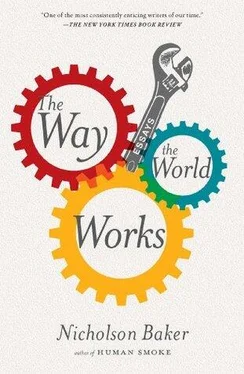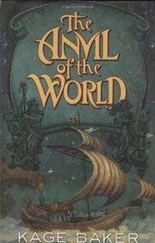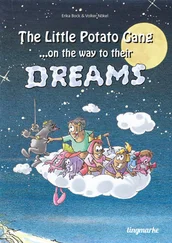Nicholson Baker - The Way the World Works
Здесь есть возможность читать онлайн «Nicholson Baker - The Way the World Works» весь текст электронной книги совершенно бесплатно (целиком полную версию без сокращений). В некоторых случаях можно слушать аудио, скачать через торрент в формате fb2 и присутствует краткое содержание. Год выпуска: 2012, Издательство: Simon & Schuster, Жанр: Публицистика, Критика, на английском языке. Описание произведения, (предисловие) а так же отзывы посетителей доступны на портале библиотеки ЛибКат.
- Название:The Way the World Works
- Автор:
- Издательство:Simon & Schuster
- Жанр:
- Год:2012
- ISBN:нет данных
- Рейтинг книги:4 / 5. Голосов: 1
-
Избранное:Добавить в избранное
- Отзывы:
-
Ваша оценка:
- 80
- 1
- 2
- 3
- 4
- 5
The Way the World Works: краткое содержание, описание и аннотация
Предлагаем к чтению аннотацию, описание, краткое содержание или предисловие (зависит от того, что написал сам автор книги «The Way the World Works»). Если вы не нашли необходимую информацию о книге — напишите в комментариях, мы постараемся отыскать её.
), here assembles his best short pieces from the last fifteen years.
The Way the World Works
OED
Modern Warfare 2
Through all these pieces, many written for
, and
, Baker shines the light of an inexpugnable curiosity.
is a keen-minded, generous-spirited compendium by a modern American master.
The Way the World Works — читать онлайн бесплатно полную книгу (весь текст) целиком
Ниже представлен текст книги, разбитый по страницам. Система сохранения места последней прочитанной страницы, позволяет с удобством читать онлайн бесплатно книгу «The Way the World Works», без необходимости каждый раз заново искать на чём Вы остановились. Поставьте закладку, и сможете в любой момент перейти на страницу, на которой закончили чтение.
Интервал:
Закладка:
Dowlin, who is a respected figure among library managers, has announced that he is running for the presidency of the American Library Association next year. He narrowly lost his first race for the ALA presidency, in 1987: “TRUCKIN’ FOR THE FUTURE: Ken Dowlin for ALA President,” his campaign stickers said. In his role as ALA luminary, Dowlin (who spent six years in the Marine Corps before a part-time job driving a bookmobile diverted his interest toward library administration) sometimes quotes business theorists like Everett M. Rogers, whom he has called “my guru for change.” One of Rogers’s books lists four ways to transform an organization — by destroying it, by restructuring it, by changing the individuals within it, and by introducing new technology. In a 1992 ALA talk (part of a forum entitled “Electronic Reference in the 21st Century: Innovation Through People, Money, and Imagination”), after citing Rogers’s four ways, Dowlin went on to offer a fifth: “I can tell you what happens when you get an earthquake that puts five hundred thousand books on the floor. It’s a perfect opportunity to rearrange them.”
The Loma Prieta earthquake of October 1989 allowed Dowlin and the department managers, after closing the stacks to the public (in part for safety reasons), to combine departments, forming a template for the New Main. The literature and history departments were fused first. By the time the new building opened, the administration had, in spite of a petition signed by twenty-seven librarians, folded sports, recreation, and most of the sciences into a catch-all category now known as General Collections and Humanities. Cell biology, tree books, Elizabethan poetry, cookery, model trains, and pets were now all in the same group, and reshuffled librarians no longer necessarily had a close familiarity with the collection they oversaw.
Following the earthquake, Dowlin kept the library closed for two and a half months in order to complete this reorganization, even though some of his staff told him that they were prepared to open with at least partial services much earlier. Meanwhile large numbers of books were moving all over the place. A branch information memo, dated December 7, 1989, advised, “There will be no discard pickups until the discard room at the Main Library can be cleared. It is so full it has become a fire hazard.” Between 150,000 and 200,000 infrequently checked-out books (including a nice collection of old travel books) went to an abandoned medical building, where they were stored in hospital rooms. Some of the rooms had broken windows; most were without shades or curtains. Some three thousand books were damaged beyond repair from mold and water and were thrown away. Back at the library, thousands of books that had never been entered into the computer were taken to a room on the third floor in the north wing. They sat there for several months; then every department was asked to go through these “Not On File”s, or NOFs, and make decisions about whether they ought to be kept or “deselected.” The room thus came to be known as the Deselection Chamber. For a brief time during this period, according to one librarian, the DPW trucks were leaving with loads of books several times a week.
The NOFs that survived remained boxed for about five years, inaccessible, as cardboard sagged and collapsed, and bindings within gave way. They could have been reshelved, but they weren’t. They weren’t in the computer; they were “out-of-date material”—why spend money to reshelve them? Dowlin had already signaled his intention before the earthquake, when he told a reporter for the Bay Guardian that he planned to clean out what he called the “Augean stables” of the library. King Augeus, remember, had a problem with a backlog of ox dung, and Hercules managed this situation by redirecting the flow of a convenient river. One of Dowlin’s labors was to channel the river of federal earthquake-relief money toward his library. The FEMA grant application that his staff prepared requested money for (among other sensible things like physical repairs and book rebinding) a new computer system, in order to inventory earthquake-dislocated books. FEMA obliged with a large sum. The card catalog was frozen in 1991, and the library, with additional municipal and private funding, signed a multimillion-dollar lease agreement with Digital Equipment and brought its new catalog online.
Some books were repaired with FEMA money; others were simply thrown away. It wasn’t until a few months before the move to the New Main that thousands of damaged books — many of them rare — stored since the earthquake in a low-ceilinged nook known as the Mouse House, about a block from the library, went out for repairs. Rather than actually repairing these books, according to one librarian, the library devoted its resources to the routine repair of circulating books damaged after the earthquake.
Repairing old books in-house would take a more sophisticated preservation program than the library is willing to commit to, even though Dowlin has served on an ALA president’s committee on book preservation. An ensemble of new equipment for preserving manuscript pages — including an ultrasonic welder and a water-filtration and de-ionization system — remains unused (except for the welder, which is occasionally employed to make signs for the library), and many nineteenth-century works are shipped to a commercial service that shears off the decorated publisher’s bindings and encases the books’ interiors in plain cloth.
In the sixties, William Holman, then the city librarian, began an ambitious program of book buying (out-of-print as well as new books), with the intention of turning SFPL into a high-level research library — not quite as high-level as the New York Public, but worthy even so of San Francisco’s literary past, with pockets of eccentric comprehensiveness. Subsequent city librarians built on Holman’s hoard, until Dowlin arrived with an alternative vision. “First and foremost,” Dowlin wrote in a letter to the Chronicle not long ago, “SFPL is a public library, not a research facility.” It’s both, of course, and the books and scholarly journals stored in Brooks Hall — a vast, dusty space under the street which the library borrowed recently to store its overflow — belie Dowlin’s claim. The entire McComas Collection of Science Fiction and Fantasy — including unbound copies of Amazing Stories going back to 1929—resides in this offsite mega-crypt, as do the locked-case books, each with an acid-free identifying tag, that used to be kept behind glass in the old history-and-social-sciences department: John Gould’s eight-volume Birds of Australia (a set of which sold at auction last March for over a quarter of a million dollars), for instance, and Bligh’s A Voyage to the South Sea . (Patrons who want to consult these materials must make a special request, and wait until the next day.) A librarian was surprised to discover Athanasius Kircher’s beautifully engraved fantasia on the Roman countryside, published in 1671, on a high shelf down in Brooks Hall. This is a book dealer’s paradise, sitting unprotected in the squalor of a storage area, near carpet remnants and construction debris.
Brooks Hall holds what it holds partly because there isn’t enough room in the New Main. But partly, too, its contents simply don’t accord with the altered conception — fashionable now among some circulation-sensitive library managers — of the public library’s true mission. In August 1992, Dowlin introduced the concept of “leveled access” in the humanities to the San Francisco Planning Commission. Leveled access involves offering the public, in Mr. Dowlin’s words, “a large, generally accessible collection that is designed essentially to be current material — if you will, a mass selection.” This mass of material would be supplemented by “focus collections” in selected areas, such as art and music. What nobody outside the library quite understood was that the leveling implicit in leveled access was apparently meant to be retroactive; in other words, that Dowlin’s plan would involve downsizing what had already been achieved, at considerable expense, by his predecessors.
Читать дальшеИнтервал:
Закладка:
Похожие книги на «The Way the World Works»
Представляем Вашему вниманию похожие книги на «The Way the World Works» списком для выбора. Мы отобрали схожую по названию и смыслу литературу в надежде предоставить читателям больше вариантов отыскать новые, интересные, ещё непрочитанные произведения.
Обсуждение, отзывы о книге «The Way the World Works» и просто собственные мнения читателей. Оставьте ваши комментарии, напишите, что Вы думаете о произведении, его смысле или главных героях. Укажите что конкретно понравилось, а что нет, и почему Вы так считаете.












